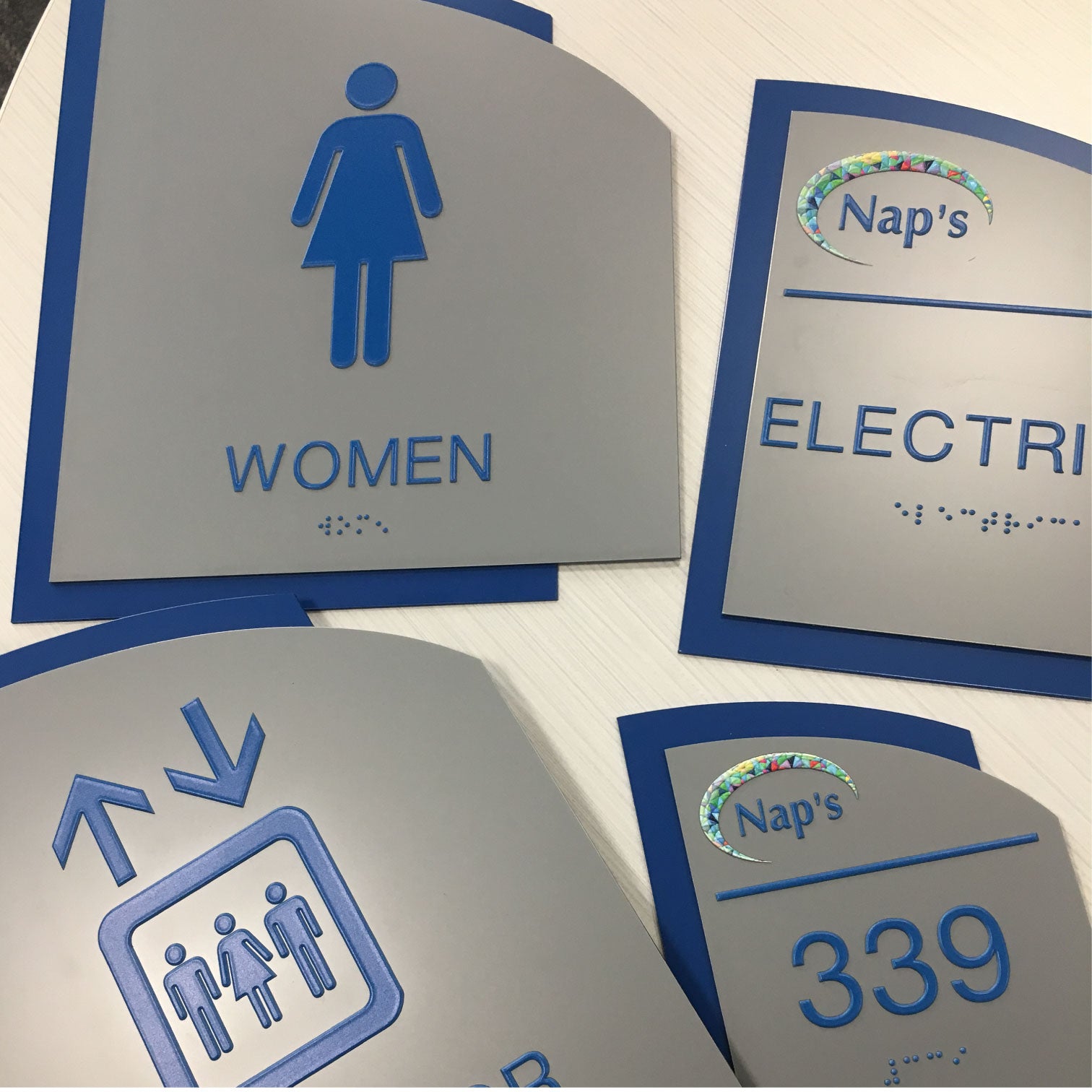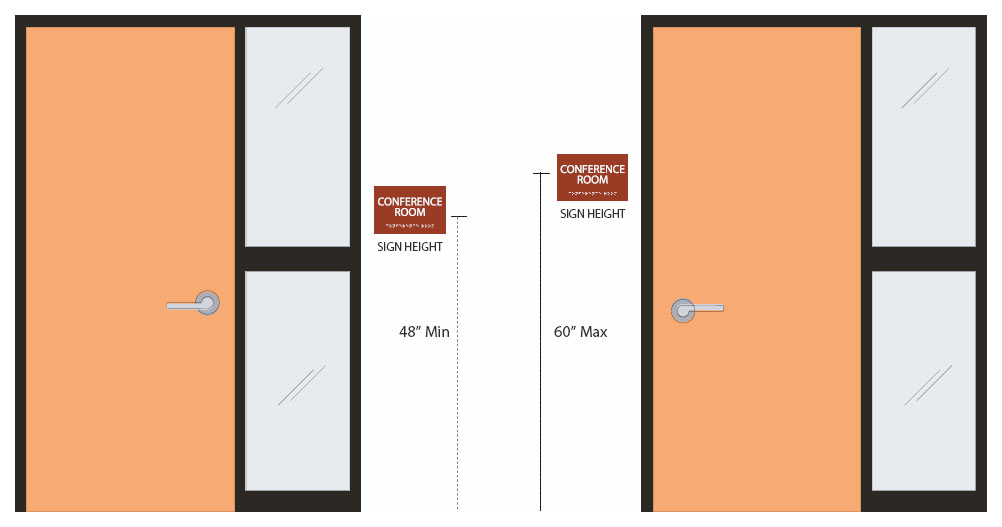ADA Signs: Vital Devices for Inclusive Atmospheres
ADA Signs: Vital Devices for Inclusive Atmospheres
Blog Article
Exploring the Trick Functions of ADA Indicators for Boosted Access
In the realm of accessibility, ADA signs serve as silent yet effective allies, ensuring that spaces are comprehensive and accessible for individuals with handicaps. By integrating Braille and responsive components, these indicators break obstacles for the visually damaged, while high-contrast color plans and understandable fonts cater to varied aesthetic demands.
Relevance of ADA Compliance
Guaranteeing compliance with the Americans with Disabilities Act (ADA) is crucial for promoting inclusivity and equivalent accessibility in public areas and work environments. The ADA, enacted in 1990, mandates that all public facilities, employers, and transportation services suit individuals with specials needs, guaranteeing they enjoy the exact same legal rights and possibilities as others. Conformity with ADA standards not only fulfills legal responsibilities however additionally boosts a company's credibility by demonstrating its commitment to diversity and inclusivity.
One of the crucial facets of ADA conformity is the application of accessible signs. ADA indicators are developed to make sure that people with specials needs can quickly browse with spaces and buildings.
Furthermore, adhering to ADA regulations can minimize the threat of prospective fines and legal effects. Organizations that fall short to abide by ADA guidelines may encounter claims or charges, which can be both financially challenging and harmful to their public image. Hence, ADA compliance is integral to promoting an equitable environment for everyone.
Braille and Tactile Aspects
The consolidation of Braille and responsive elements into ADA signage personifies the concepts of availability and inclusivity. It is typically placed below the equivalent message on signs to ensure that individuals can access the info without aesthetic support.
Tactile aspects prolong past Braille and include increased icons and characters. These components are developed to be discernible by touch, permitting people to determine space numbers, washrooms, exits, and other crucial areas. The ADA sets certain standards relating to the dimension, spacing, and positioning of these responsive aspects to enhance readability and make sure consistency across various environments.

High-Contrast Color Design
High-contrast shade systems play an essential function in improving the presence and readability of ADA signage for individuals with visual impairments. These plans are crucial as they optimize the distinction in light reflectance in between text and history, making sure that indicators are quickly discernible, even from a distance. The Americans with Disabilities Act (ADA) mandates making use of certain you can try this out shade contrasts to fit those with limited vision, making it a critical element of compliance.
The efficiency of high-contrast colors exists in their capability to stand out in different lighting problems, including poorly lit atmospheres and areas with glow. Normally, dark text on a light history or light text on a dark history is employed to accomplish optimal contrast. As an example, black text on a white or yellow history gives a stark visual distinction that assists in fast recognition and understanding.

Legible Fonts and Text Dimension
When taking into consideration the layout of ADA signs, the selection of understandable typefaces and appropriate text size can not be overstated. The Americans with Disabilities Act (ADA) mandates that typefaces should be sans-serif and top article not italic, oblique, manuscript, extremely ornamental, or of unusual kind.
The dimension of the text additionally plays an essential role in ease of access. According to ADA guidelines, the minimal text height need to be 5/8 inch, and it must enhance proportionally with viewing range. This is particularly essential in public rooms where signage requirements to be read promptly and properly. Consistency in message size adds to a natural visual experience, assisting individuals in navigating settings effectively.
Moreover, spacing in between letters and lines is indispensable to readability. Appropriate spacing stops personalities from appearing crowded, boosting readability. By adhering to these requirements, designers can dramatically enhance accessibility, making sure that signs serves visit its desired purpose for all people, regardless of their visual capacities.
Effective Placement Approaches
Strategic placement of ADA signs is important for maximizing accessibility and guaranteeing compliance with legal requirements. ADA guidelines stipulate that signs ought to be placed at a height in between 48 to 60 inches from the ground to ensure they are within the line of view for both standing and seated people.
In addition, indications need to be placed adjacent to the lock side of doors to enable easy recognition before access. Consistency in indicator placement throughout a center enhances predictability, reducing complication and boosting total individual experience.

Final Thought
ADA indicators play a vital role in advertising accessibility by incorporating attributes that resolve the needs of people with impairments. These components collectively foster a comprehensive atmosphere, highlighting the value of ADA compliance in guaranteeing equivalent gain access to for all.
In the realm of ease of access, ADA signs offer as quiet yet powerful allies, making sure that rooms are navigable and inclusive for individuals with disabilities. The ADA, established in 1990, mandates that all public centers, employers, and transport solutions fit individuals with handicaps, guaranteeing they take pleasure in the same rights and possibilities as others. ADA Signs. ADA indications are developed to ensure that people with specials needs can quickly navigate via buildings and spaces. ADA standards state that signs should be placed at an elevation between 48 to 60 inches from the ground to ensure they are within the line of view for both standing and seated individuals.ADA signs play an essential duty in promoting accessibility by incorporating functions that address the needs of people with specials needs
Report this page